Publikationen
Eine vollständige Liste aller am Institut für Mathematik verfassten Publikationen finden Sie in der Forschungsdokumentation (FoDok).
Ausgewählte Publikationen
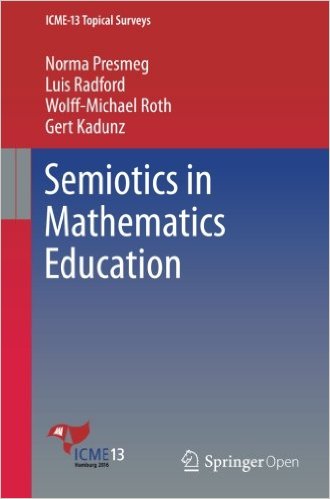

Gert Kadunz, Norma Presmeg, Luis Radford, Michael Roth: Semiotics in Mathematics Education. Springer, Berlin, Mai 2016.
This volume discusses semiotics in mathematics education as an activity with a formal sign system, in which each sign represents something else. Theories presented by Saussure, Peirce, Vygotsky and other writers on semiotics are summarized in their relevance to the teaching and learning of mathematics. The significance of signs for mathematics education lies in their ubiquitous use in every branch of mathematics. Such use involves seeing the general in the particular, a process that is not always clear to learners. Therefore, in several traditional frameworks, semiotics has the potential to serve as a powerful conceptual lens in investigating diverse topics in mathematics education research. Topics that are implicated include (but are not limited to): the birth of signs; embodiment, gestures and artifacts; segmentation and communicative fields; cultural mediation; social semiotics; linguistic theories; chains of signification; semiotic bundles; relationships among various sign systems; intersubjectivity; diagrammatic and inferential reasoning; and semiotics as the focus of innovative learning and teaching materials.
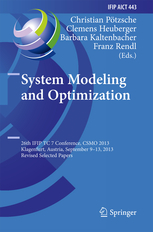
C. Pötzsche, C. Heuberger, B. Kaltenbacher, F. Rendl (eds.). System Modeling and Optimization, 26th IFIP TC 7 Conference, CSMO 2013, Klagenfurt, Austria, September 9-13, 2013, revised selected papers, IFIP Advances in Information and Communication Technology, Springer, Heidelberg etc., 2014
This book is a collection of thoroughly refereed papers presented at the 26th IFIP TC 7 Conference on System Modeling and Optimization, held in Klagenfurt, Austria, in September 2013. The 34 revised papers were carefully selected from numerous submissions. They cover the latest progress in a wide range of topics such as optimal control of ordinary and partial differential equations, modeling and simulation, inverse problems, nonlinear, discrete, and stochastic optimization as well as industrial applications.
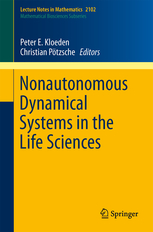
P. Kloeden and C. Pötzsche (eds.). Nonautonomous dynamical systems in the life sciences. Lect. Notes Math. 2102 (Mathematical Biosciences Subseries), Springer, Heidelberg etc., 2013.
Nonautonomous dynamics describes the qualitative behavior of evolutionary differential and difference equations, whose right-hand side is explicitly time dependent. Over recent years, the theory of such systems has developed into a highly active field related to, yet recognizably distinct from that of classical autonomous dynamical systems. This development was motivated by problems of applied mathematics, in particular in the life sciences where genuinely nonautonomous systems abound. The purpose of this monograph is to indicate through selected, representative examples how often nonautonomous systems occur in the life sciences and to outline the new concepts and tools from the theory of nonautonomous dynamical systems that are now available for their investigation.
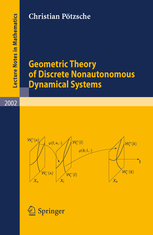
C. Pötzsche. Geometric theory of discrete nonautonomous dynamical systems, Lect. Notes Math. 2002, Springer, Heidelberg etc., 2010.
Nonautonomous dynamical systems provide a mathematical framework for temporally changing phenomena, where the law of evolution varies in time due to seasonal, modulation, controlling or even random effects. Our goal is to provide an approach to the corresponding geometric theory of nonautonomous discrete dynamical systems in infinite-dimensional spaces by virtue of 2-parameter semigroups (processes). These dynamical systems are generated by implicit difference equations, which explicitly depend on time. Compactness and dissipativity conditions are provided for such problems in order to have attractors using the natural concept of pullback convergence. Concerning a necessary linear theory, our hyperbolicity concept is based on exponential dichotomies and splittings. This concept is in turn used to construct nonautonomous invariant manifolds, so-called fiber bundles, and deduce linearization theorems. The results are illustrated using temporal and full discretizations of evolutionary differential equations.
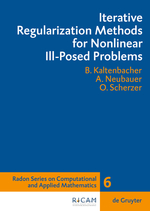
Barbara Kaltenbacher, Andreas Neubauer, Otmar Scherzer ITERATIVE REGULARIZATION METHODS FOR NONLINEAR ILL-POSED PROBLEMS
Nonlinear inverse problems appear in many applications, and typically they lead
to mathematical models that are ill-posed, i.e., they are unstable under data
perturbations. Those problems require a regularization, i.e., a special numerical
treatment. This book presents regularization schemes which are based on
iteration methods, e.g., nonlinear Landweber iteration, level set methods,
multilevel methods and Newton type methods.

Thomas Schuster, Barbara Kaltenbacher, Bernd Hofmann, Kamil S. Kazimierski REGULARIZATION METHODS IN BANACH SPACES
Regularization methods aimed at finding stable approximate solutions are a
necessary tool to tackle inverse and ill-posed problems. Inverse problems arise in
a large variety of applications ranging from medical imaging and nondestructive
testing via finance to systems biology. Many of these problems
belong to the class of parameter identification problems in partial differential
equations (PDEs) and thus are computationally demanding and mathematically
challenging. Hence there is a substantial need for stable and efficient solvers for
this kind of problems as well as for a rigorous convergence analysis of these
methods.
This monograph consists of five parts. Part I motivates the importance of
developing and analyzing regularization methods in Banach spaces by
presenting four applications which intrinsically demand for a Banach space
setting and giving a brief glimpse of sparsity constraints. Part II summarizes all
mathematical tools that are necessary to carry out an analysis in Banach spaces.
Part III represents the current state-of-the-art concerning Tikhonov
regularization in Banach spaces. Part IV about iterative regularization methods is
concerned with linear operator equations and the iterative solution of nonlinear
operator equations by gradient type methods and the iteratively regularized
Gauß-Newton method. Part V finally outlines the method of approximate inverse
which is based on the efficient evaluation of the measured data with
reconstruction kernels.
Quicklinks
Plattformen

Informationen für
Adresse
Universitätsstraße 65-67
9020 Klagenfurt am Wörthersee
Austria
+43 463 2700
uni [at] aau [dot] at
www.aau.at
Campus Plan












